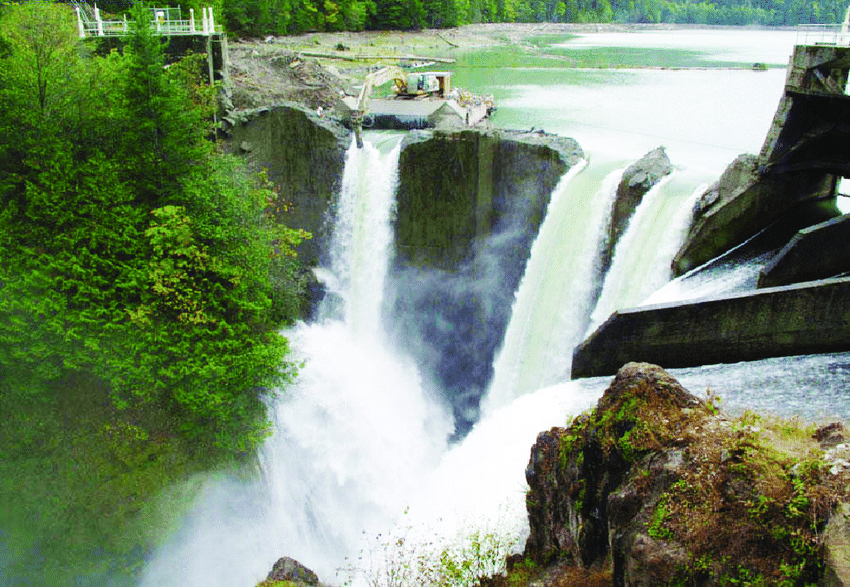When dams are removed, a variety of experts from engineers to hydrologists and biologists develop plans to minimize negative impacts on aquatic life. When PG&E’s license for the Potter Valley Project on the Eel River expired last month, that began the decommissioning process which will ultimately lead to dam removal. Many studies have already been completed which evaluate options for dam removal, the potential for an ecologically appropriate continued diversion, and much more. This blog will focus on a study prepared by McMillen Jacobs Associates evaluating options for Scott dam removal.
The 100-year-old Scott dam, a total barrier to fish passage, is located about 160 miles upstream from the mouth of the Eel River, about 30 miles NE of Ukiah. It is a concrete dam standing roughly 140 feet tall and spanning 805 feet. Scott dam impounds the mainstem Eel to form Lake Pillsbury, a reservoir with a current capacity of around 65,000 acre feet. For reference, Shasta Lake reservoir is the largest in the state and has a capacity of over 4,500,000 acre feet.
What About All That Sediment?
Lake Pillsbury reservoir used to have a much larger storage capacity, about 90,000 acre feet. But, given that the Eel has the highest suspended sediment load for any river of its size in North America, much of the reservoir has filled with sediment. So the question of how to handle all the sediment accumulated behind the dams is significant.
One important study, which we’ll cover in greater detail later this year, analyzed the physical and chemical makeup of sediment in Lake Pillsbury and Van Arsdale reservoirs. This study concluded that sediments in both reservoirs are generally not contaminated. This is great news for dam removal because it means that sediment will not have to be manually removed from the reservoirs ahead of dam removal.
Given the conclusions of the sediment study, McMillen Jacobs Associates analyzed two potential approaches for Scott dam removal; rapid and phased removal. These two options have comparable cost estimates and feasibility, and mostly differ in their impacts to downstream aquatic life. Both approaches would result in elevated levels of suspended sediment. However, rapid removal would have a low likelihood of direct impacts on most species.
Because the rapid removal approach appears to be the clear winner for limiting impacts on aquatic life (and a slightly lower estimated cost by about $7 million), we will focus on that option.
The Process
Dam removal would begin during the low flow season, typically June – October, with excavation of a tunnel on the downstream side of the dam. The tunnel, about 10 – 15 feet in diameter, would stop short of going all the way through the dam, leaving a concrete plug in place.
Possibly at the same time, dam lowering would begin. Barge-mounted machinery would be used to remove infrastructure from the top of the dam like gates, hoists, grating and more. Then a hydraulic impact hammer would be used to lower the dam by removing chunks from the top. This is similar to the approach used in the 2015 Glines Canyon dam removal from the Elwha River in Washington State.

A hoe ram mounted on a floating barge lowering Glines Canyon Dam on the Elwha River in Washington State | photo credit: USGS, 2015
In the year between dam lowering, and sediment flushing and full dam removal, the dam will still need to be capable of withstanding large flood events. This assurance will require additional analysis and approval from the California Division of Safety of Dams.
Sediment flushing would begin when weather forecasts significant rain – enough to flush sediments from the reservoirs. Explosives would be set and detonated at the concrete plug left in the newly excavated tunnel. The rapid removal approach would result in a one-time increase in suspended sediment which would most likely last about four days given a streamflow of around 2,000cfs.
Once sediment flushing is complete and flows are low again in the summer, final dam removal and channel rehabilitation can begin. These activities would likely last through the entire low flow season, ending prior to December.
| Bottom Line |
| Scott dam removal could take as little as two years. Estimated costs for Scott dam removal are not yet refined, but hover around $69 million. And that doesn’t include Cape Horn dam removal – which is necessary to ensure that fish can access the abundant cold-water habitat in the upper basin. |
Reference
McMillen Jacobs Associates. (November 2021). Scott Dam and Cape Horn Dam Removal Alternatives. A technical memo prepared for the Two Basin Solution Partners.
